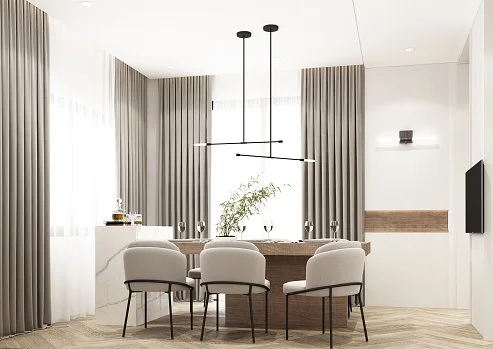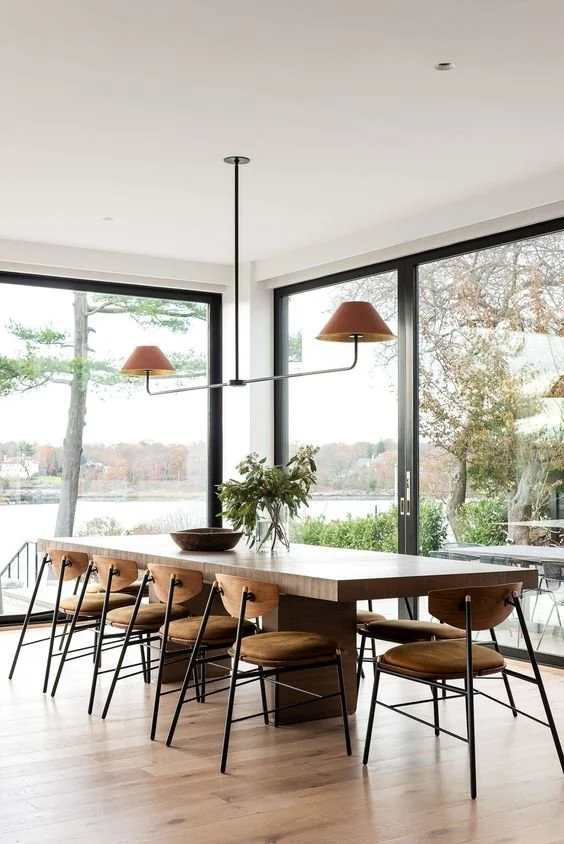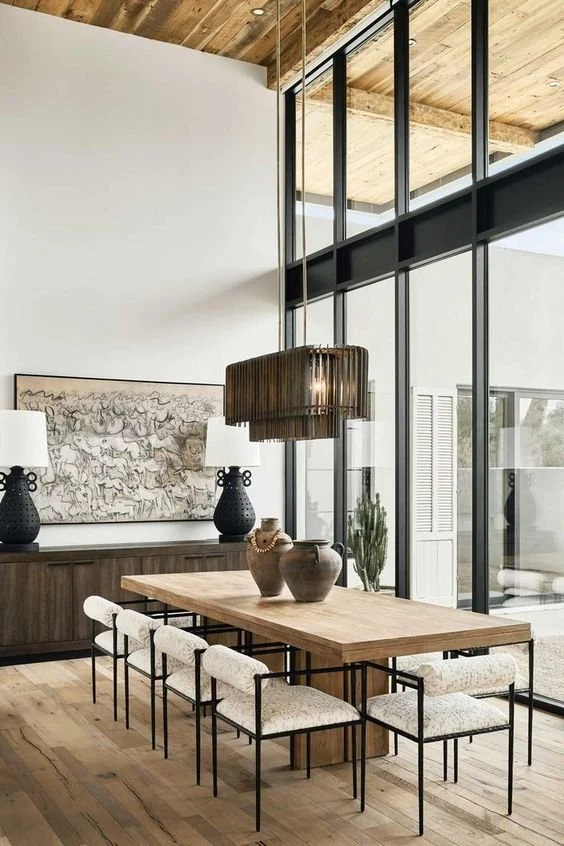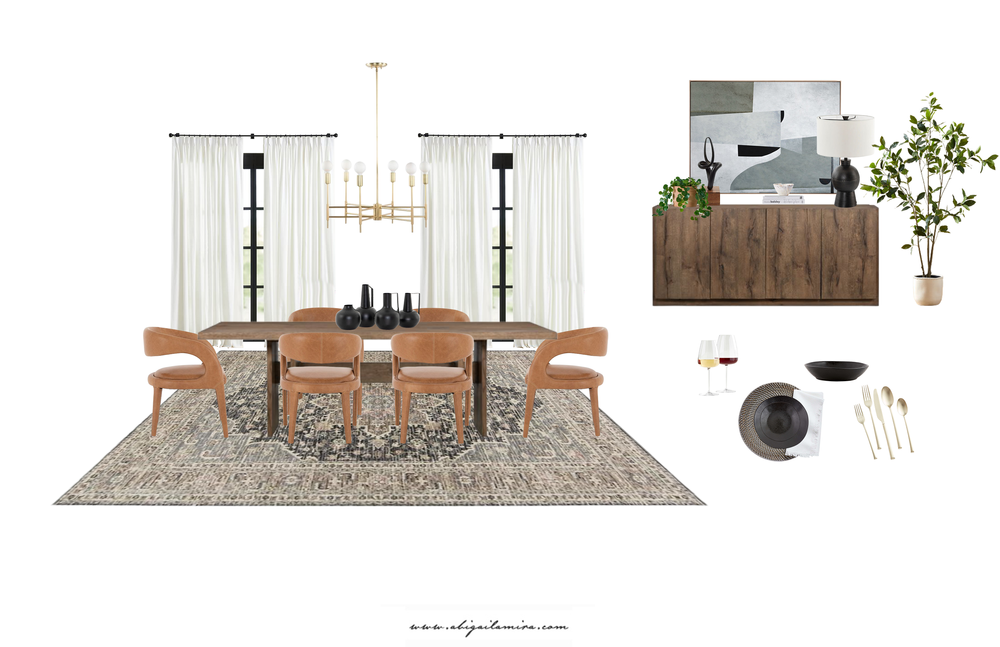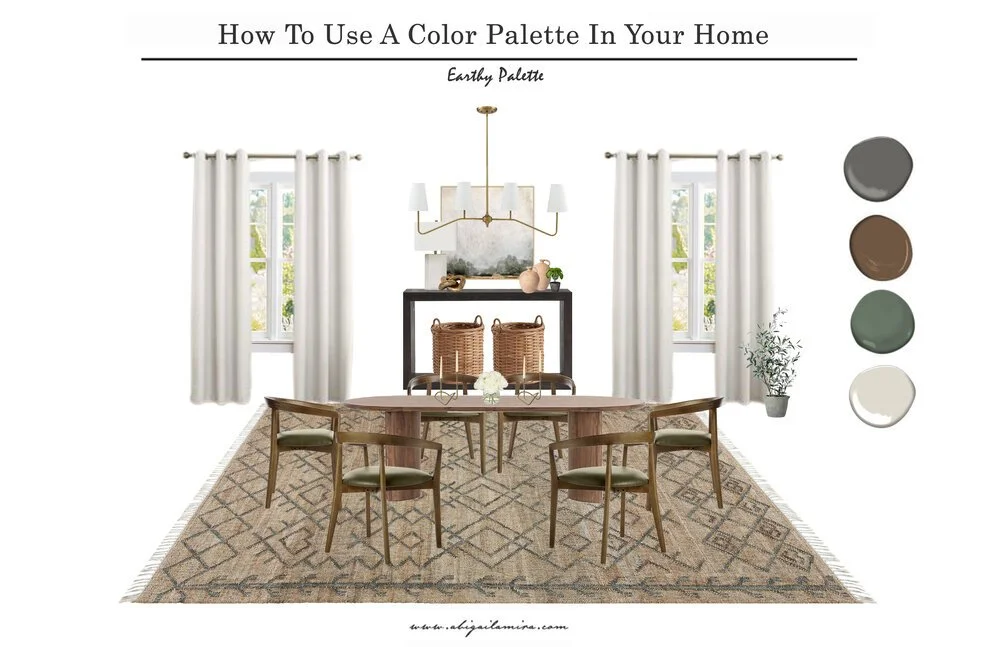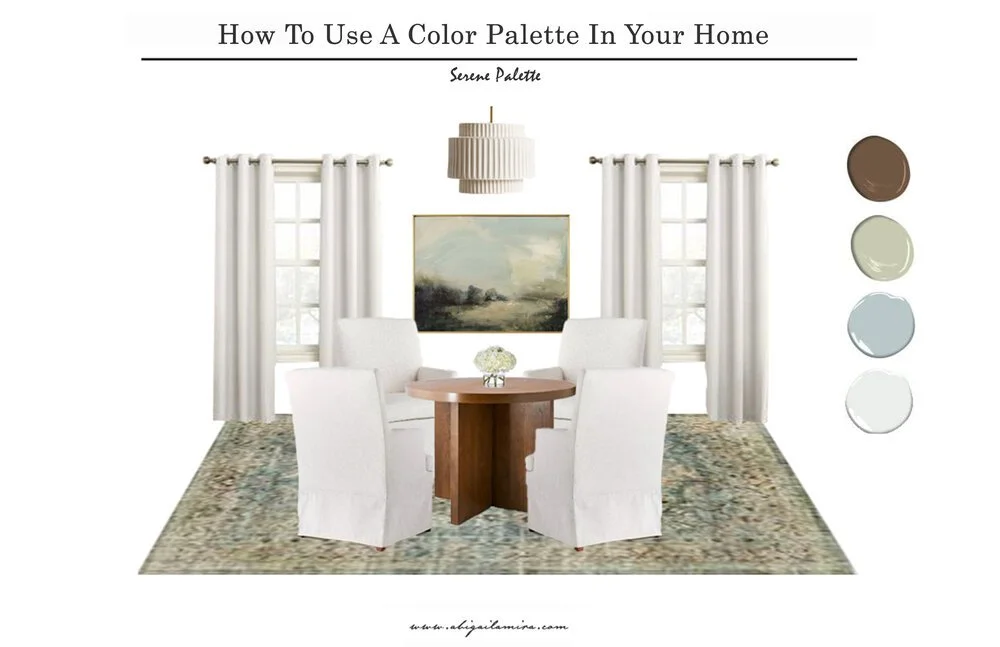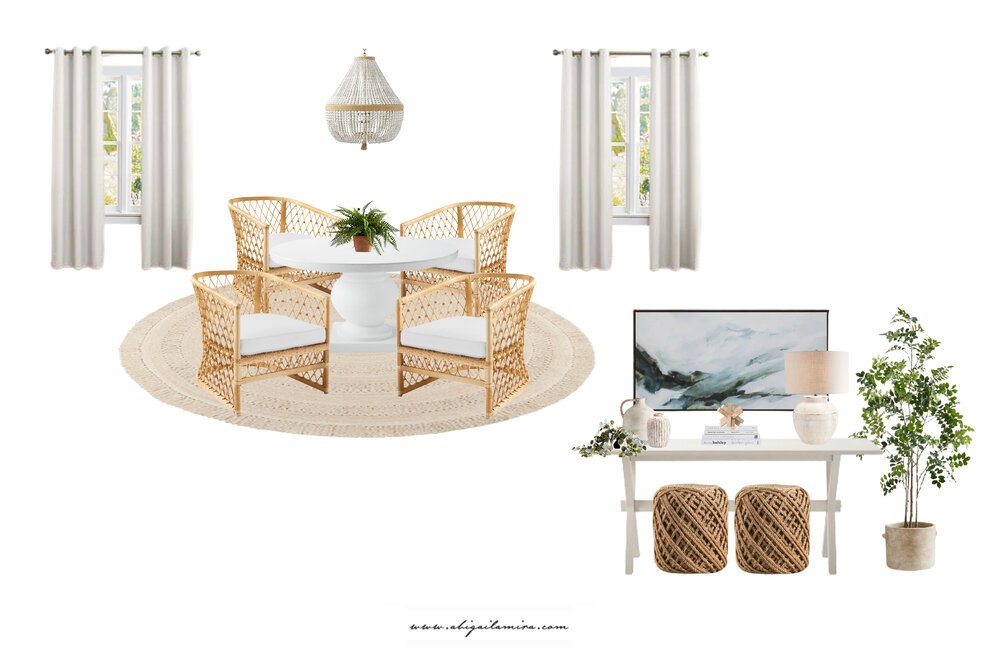Do you love to entertain friends and family but your dining room doesn’t seem to reflect that? This blog post is just for you! I am sharing my design knowledge to help you design a dining room just like a designer. You may be like my family and use your dining room table for more than just eating and entertaining. It can be a place to help with school work, do crafts, play board games, and have conversations over tea(or wine). I want my friends and family to be comfortable so we can linger long after the meal is over but I also want the room to look beautiful and “pulled together”. I have a feeling you may want those things for your home too. Choosing the right pieces for your family can be daunting, but I am hoping I can make it a little bit easier. Where should you begin and how do you choose the right pieces? I will share with you my designer tips and tricks that will help you create a dining room perfect for hosting.
Source: Pottery Barn
The Importance Of Measuring
The first thing you want to do is measure your room. This step should never be overlooked! You could fall in love with a dining set at the store only to bring it home and the pieces not fit in your space properly, leaving you feeling dissatisfied. Not only do you want to measure the room itself but you will also want to measure the space the chairs will need when they are pulled out from the table. Ideally, you need a minimum of 36” between your table and the wall (or any furniture behind chairs) so the chairs can pull out easily. Don’t forget to measure the space around your table (or the table you are interested in purchasing) to see how many chairs you will need. You want to allow at least 24” per chair along the table and if possible, a 6” buffer on each end of the table. If your table extends, you should determine if you need extra chairs and where to store them when not in use.
Source: Tiffany Leigh Design
Comfort Is Key
Now that you have your measurements done, we can move on to the first question I like to ask my clients “Do you want your dining room to be formal or informal?”. Once you have answered this question, you should consider comfort. The biggest concerns my clients usually have is fitting everyone around the table and comfort. Everybody has a different comfort level, but here are some tips to help you choose the best option for your family. Look for chairs that are wide enough so you’re not having to shift around to find a comfortable spot. The back of the chair shouldn’t lean too far back and if it’s upholstered, make sure it has adequate padding. Consider using benches or my personal favorite a banquette, not only is it a space saver but the upholstered options are very comfortable and may have bonus storage.
Source: Lindye Galloway
Choosing The Right Style
When thinking about the dining room table, you should consider the size and shape of your room. If you have a large, rectangular space a traditional rectangle-shaped table may be best suited. If your dining room is a high-traffic area in your home, an oval or round-shaped table can provide a better traffic flow. There are several different styles of table bases like the traditional four legs (if your table extends very long, keeping mind that you may need additional support legs), and the trestle style which can sometimes block your chairs from being pushed in all the way, a pedestal style often found on round or oval-shaped tables (think “tulip” style tables), a sawhorse base, which is made up of two a-frame style support bases that hold up a solid top and the waterfall style with its solid top that continues down the sides as legs.
Source: Pottery Barn
Storage
Along with the table and chairs, you may also need some storage or a place to serve food and drinks. Some types of storage pieces to consider are built-ins (if you’re lucky!), sideboards, buffets, hutch, or china cabinets depending on what kind of storage you need. A sideboard and buffet both offer a long surface area for serving food and drinks. Buffets may or may not have additional closed storage, while the sideboard has a nice amount of closed storage. Generally, sideboards are narrower and have shorter legs than a buffet with cabinets that go down to the floor. A hutch or china cabinet both show off your dishes and often have some closed storage. The main difference between the two is that a hutch is two pieces, the hutch and the cabinet while the china cabinet is one single piece.
Source: Behance
Scale And Balance
From your measurements, you can decide on the right scale. Scale refers to the visual size of each piece of furniture and how they relate to the room and other furniture in the same space. Basically what that means is if you have a larger space, you will need larger furniture with well-defined shapes (not necessarily more furniture just to fill in the room). If you are working with a smaller space, you might want to consider smaller or more delicate pieces (open-back chairs can give the illusion of more space!). Your furniture should fit your room appropriately. That being said, you also want to consider balancing visual weights. If you have a large rectangular dining table or storage piece, try placing a large painting on the wall to balance it out.
Source: Studio McGee
Lighting
Creating the right mood with lighting is easier than you think. You want your overhead lighting (above the table) to be about 30”-36” high from the tabletop to the bottom of the light. This keeps things cozy and functional without blocking sightlines (we want to encourage table talk as much as we can!) Traditionally, you will find a chandelier or pendant light above the table. The difference between the two is that chandeliers have multiple lights while pendants typically only have one. I like to go as large as I can with whatever light is above the table but here are a couple of things to keep in mind, any light you choose, be sure its width does not exceed the table’s width. You want your light’s width to be about 2/3 of your table width. You can use more than one light for long tables to create more drama, like two chandeliers or pendants. Add sconces or picture lights to create even more ambiance. Hang sconces around 6 feet high unless you have high ceilings and if you are using more than one, be sure they are all hung at the same height throughout the room. Love the look of sconces and picture lights but don’t want to hire an electrician to install them? You can now find the plug-in or battery-operated options out there (see here), use conduit painted the same color as your wall to hide the cord (renter-friendly!).
Source: Studio McGee
Rug Or Not to Rug
This is the most controversial decision my clients have for the dining room. Some people are strongly against having a rug underneath the dining table while others prefer it. I personally love rugs under the dining table and I will share with you why I do. A rug will anchor the eating space, create more defined walkways, add a pop of color, can prevent the chairs from scraping the flooring, and I have very cold hands/feet so I like my feet to be on a rug instead of the bare floor. I always recommend going as large as you can with your rug (in any room), you definitely want to ensure you have a minimum of 3 feet from the edge of the table to the end of the rug so you can easily pull out chairs without their legs slipping off of the rug (nobody wants to sit in a wobbly chair).
Source: Amber Interiors
Chair Arm Preference
Should your chairs have arms? Traditionally, you find armchairs at the ends of the table and armless versions on the sides. I believe this rule can (and should) be broken. Depending on the size of your space and how your family uses it, should determine the arms you choose. Armless chairs save on space and can look very modern all around your table. Meanwhile, armchairs are often more comfortable, especially for those that have joint problems, but they take up more space. A bench option can also be great for families with young children and I highly recommend considering a banquette at any stage in your life.
Source: Design Files
Material Options
There are so many different types of materials out there. Wooden chairs are classic and come in so many different styles and finishes. Metals chairs can provide contrast and interest in your space. Acrylic chairs can be so unexpected in a dining room and they are perfect for small spaces. Natural fiber chairs like rattan provide warmth and texture to any room. Upholstered chairs are timeless and allow you to bring in color, texture, and patterns. They can also help soften the hard lines in your dining room. I love to mix materials to create a collected over time, cozy feel. For example, pair wooden side chairs with upholstered statement chairs at the ends of the table.
Source: Joanna Gaines
Show Your Personality With Fabric
With upholstered chairs, you will have the opportunity to bring in colors, patterns, and textures that suit your personality. There are many different types of fabrics such as linen, velvet, leather, and the list goes on. There is also a vast selection of patterns like brocade, stripes, paisley, and so on. The fabric you choose for your chairs is very important. Depending on the formality of your room, you may want something with a pattern that won’t show stains easily or a performance fabric in a neutral tone. Slipcovers are great especially when you have small children because you can just throw them in the washer when they get dirty. The fabric you ultimately choose should reflect your personal style.
Source: Amber Interiors
Source: MARKET by Modern Nest
The Devils In The Details
Styling your dining room shouldn’t be an afterthought! I always recommend keeping the styling simple with lovely candles, big vases filled with fresh greenery, and always using cloth napkins (it makes each meal feel elevated). Use your pretty dishes, bowls, or platters as functional styling on your storage piece or table. Bring organic texture and lines with fresh-cut greenery or flowers in a big vase. Hang soft curtains to make the space fill more intimate and break up all the horizontal lines. Consider how you want to fill your walls, whether it’s a large art piece, a statement mirror, or a grouping of smaller art pieces that have lots of meaning to you. Hang what makes you happy!
Source: Pinterest
Check out these free dining room designs
Click to see the full post with shopping links
